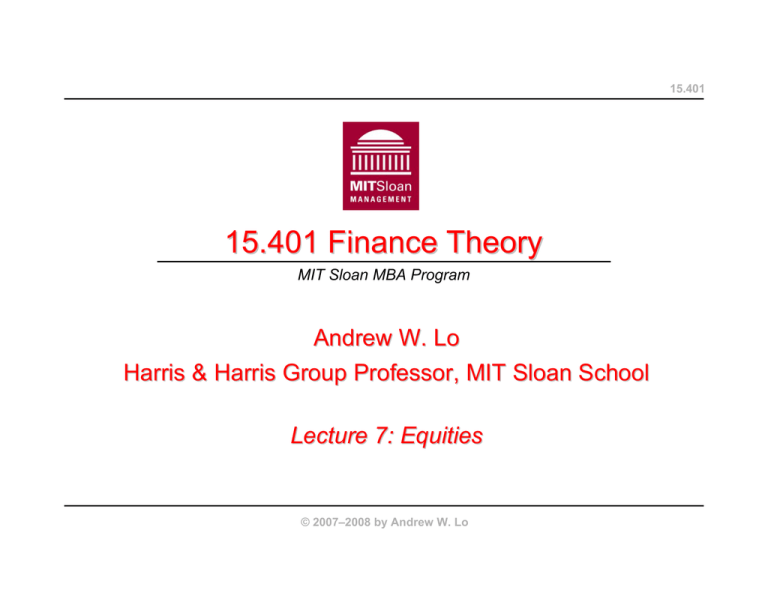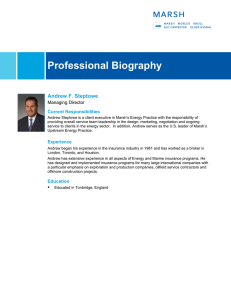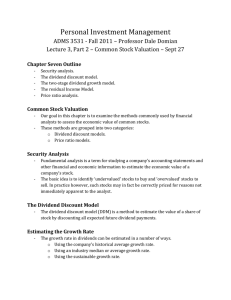15.401 Finance Theory Andrew W. Lo Lecture 7: Equities
advertisement

15.401 15.401 Finance Theory MIT Sloan MBA Program Andrew W. Lo Harris & Harris Group Professor, MIT Sloan School Lecture 7: Equities © 2007–2008 by Andrew W. Lo Critical Concepts 15.401 Industry Overview The Dividend Discount Model DDM with Multiple-Stage Growth EPS and P/E Growth Opportunities and Growth Stocks Reading Brealey, Myers and Allen, Chapter 4 Lecture 7: Equities © 2007–2008 by Andrew W. Lo Slide 2 Industry Overview 15.401 What Is Common Stock? Equity, an ownership position, in a corporation Payouts to common stock are dividends, in two forms: – Cash dividends – Stock dividends Unlike bonds, payouts are uncertain in both magnitude and timing Equity can be sold (private vs. public equity) Key Characteristics of Common Stock: Residual claimant to corporate assets (after bondholders) Limited liability Voting rights Access to public markets and ease of shortsales Lecture 7: Equities © 2007–2008 by Andrew W. Lo Slide 3 Industry Overview 15.401 The Primary Market (Underwriting) Venture capital: A company issues shares to special investment partnerships, investment institutions, and wealthy individuals Initial public offering (IPO): A company issues shares to the general public for the first time (i.e., going public) Secondary or seasoned equity offerings (SEO): A public company issues additional shares Stock issuance to the general public is usually organized by an investment bank who acts as an underwriter: it buys part or all of the issue and resells it to the public Secondary Market (Resale Market) Organized exchanges: NYSE, AMEX, NASDAQ, etc. Specialists, broker/dealers, and electronic market-making (ECNs) OTC: NASDAQ Lecture 7: Equities © 2007–2008 by Andrew W. Lo Slide 4 Industry Overview 15.401 3500 90 2890 2859 3000 1868 1960 1851 2000 1500 1317 856 1000 500 312 0 '90 1063 979 50 41 45 30 716 722 587 64 60 $ Billions $ Billions 2500 76 75 2535 2581 24 '92 '93 '94 '95 '96 '97 '98 '99 '00 '01 '02 '03 37 36 26 16 5 0 '04 30 48 16 15 '91 28 43 '90 '91 Industry Underwrites Nearly $3 Trillion in United States for Second-Straight Year '92 '93 '94 '95 '96 '97 '98 '99 '00 '01 '02 '03 '04 Initial Public Offerings* Rebound In 2004 Source: Thomson Financial *Excludes Closed-End Funds Source: Thomson Financial 1800 Announced 1200 1314 1314 1160 Completed 1031 900 731 613 600 300 0 1768 1563 1500 $ Billions 1741 1735 376 269 279 162 112 '92 834 749 771 718 592 558 528 440 383 451 167 '93 '94 Source: Thomson Financial '95 '96 '97 '98 '99 '00 '01 '02 '03 '04 U.S. M&A Cycle Turns Up Images by MIT OpenCourseWare. Lecture 7: Equities © 2007–2008 by Andrew W. Lo Slide 5 Industry Overview 15.401 NYSE Daily Share Volume vs. NYSE Composite Index 7,250 8,000 1400 1200 1000 800 2,426 2,540 600 400 2,653 1,908 200 157 0 2,739 '90 179 202 '91 '92 265 291 5,000 1457 6,876 6,946 6,440 6,300 6,236 1441 1398 5,405 1042 1240 4,148 809 3,384 674 6,000 5,000 4,000 3,000 527 346 7,000 412 2,000 NYSE Composite Average Daily Volume in Millions of Shares 1600 1,000 '93 '94 '95 '96 '97 '98 '99 NYSE Volume '00 '01 '02 '03 '04 0 NYSE Composite NASDAQ Daily Share Volume vs. NASDAQ Composite Index 4,069 1800 1757 1900 1753 1686 1801 1600 3,000 1200 1082 2,193 1000 800 600 200 4,000 3,500 1400 400 4,500 374 586 132 163 677 777 752 268 295 191 '90 '92 1,052 401 1,291 544 1,570 2,471 2,003 1,950 802 2,175 2,500 2,000 1,336 1,500 648 1,000 NASDAQ Composite Average Daily Volume in Millions of Shares 2000 500 0 0 '91 '93 '94 '95 '96 NASDAQ Volume '97 '98 '99 '00 '01 '02 '03 '04 NASDAQ Composite Images by MIT OpenCourseWare. Lecture 7: Equities © 2007–2008 by Andrew W. Lo Slide 6 The Dividend Discount Model 15.401 Most Basic Valuation Model for Common Stock Applies PV formulas to common-stock payouts Two inputs: expected future dividends, discount rate Notation: – Pt: Price of stock at t (ex-dividend) – Dt: Cash dividend at t – Et [ ]: Expectation operator (forecast) at t – rt: Risk-adjusted discount rate for cashflow at t Lecture 7: Equities © 2007–2008 by Andrew W. Lo Slide 7 The Dividend Discount Model 15.401 Most Basic Valuation Model for Common Stock Two additional simplifying assumptions: In this case, we have the first version of the dividend discount model or the discounted cashflow (DCF) model Suppose dividends grow at rate g over time (Gordon growth model): Lecture 7: Equities © 2007–2008 by Andrew W. Lo Slide 8 The Dividend Discount Model 15.401 Most Basic Valuation Model for Common Stock This provides a convenient expression for the discount rate: Lecture 7: Equities © 2007–2008 by Andrew W. Lo Slide 9 The Dividend Discount Model 15.401 Example: Dividends are expected to grow at 6% per year and the current dividend is $1 per share. The expected rate of return is 20%. What should the current stock price be? Note: DDM with constant growth gives a relation between current stock price, current dividend, dividend growth rate and the expected return. Knowing three of the variables determines the fourth. Lecture 7: Equities © 2007–2008 by Andrew W. Lo Slide 10 The Dividend Discount Model 15.401 Example: Determine the cost of capital of Duke Power. In 09/92, the dividend yield for Duke Power was D0/P0 = 0.052. Estimates of long-run growth: The cost of capital is given by Thus, Lecture 7: Equities © 2007–2008 by Andrew W. Lo Slide 11 DDM with Multiple-Stage Growth 15.401 Firms May Have Multiple Stages of Growth Growth Stage: rapidly expanding sales, high profit margins, and abnormally high growth in earnings per share, many new investment opportunities, low dividend payout ratio Transition Stage: growth rate and profit margin reduced by competition, fewer new investment opportunities, high payout ratio Mature Stage: earnings growth, payout ratio and average return on equity stabilizes for the remaining life of the firm Example: A company with D0 = $1 and r = 20% grows at 6% for the first 7 years and then drops to zero thereafter. What should its current price be? Lecture 7: Equities © 2007–2008 by Andrew W. Lo Slide 12 EPS and P/E 15.401 Dividend Forecasts Involve Many Practical Challenges Terminology: – Earnings: total profit net of depreciation and taxes – Payout Ratio p: dividend/earnings = DPS/EPS – Retained Earnings: (earnings - dividends) – Plowback Ratio b: retained earnings/total earnings – Book Value BV: cumulative retained earnings – Return on Book Equity ROE: earnings/BV Using these concepts, different valuation formulas may be derived Note: these are mostly based on accounting data, not market values Lecture 7: Equities © 2007–2008 by Andrew W. Lo Slide 13 EPS and P/E 15.401 Example: (Myers) Texas Western (TW) is expected to earn $1.00 next year. Book value per share is $10.00 now. TW plans an investment program which will increase net book assets by 8% per year. Earnings are expected to grow proportionally. The investment is financed by retained earnings. The discount rate is 10%, which is assumed to be the same as the rate of return on new investments. Price TW's share price if – TW expands at 8% forever – TW's expansion slows down to 4% after year 5 Observe that – Plowback Ratio b = (10)(0.08)/(1) = 0.8 – Payout Ratio p = (1-0.8)/(1) = 0.2 – ROE = 10% Lecture 7: Equities © 2007–2008 by Andrew W. Lo Slide 14 EPS and P/E 15.401 Example (cont): Continuing Expansion Case: Lecture 7: Equities © 2007–2008 by Andrew W. Lo Slide 15 EPS and P/E 15.401 Example (cont): 2-Stage Expansion Case. Forecast EPS, D, BVPS by year: Question: Why are the values the same under both scenarios? Lecture 7: Equities © 2007–2008 by Andrew W. Lo Slide 16 Growth Opportunities and Growth Stocks 15.401 What Are Growth Stocks? Stocks of companies that have access to growth opportunities are considered growth stocks Growth opportunities are investment opportunities that earn expected returns higher than the required rate of return on capital Example: IBM in the 60's and 70's. Note: The following may not be growth stocks – A stock with growing EPS – A stock with growing dividends – A stock with growing assets Note: The following may be growth stocks – A stock with EPS growing slower than required rate of return – A stock with DPS growing slower than required rate of return Lecture 7: Equities © 2007–2008 by Andrew W. Lo Slide 17 Growth Opportunities and Growth Stocks 15.401 Example: ABC Software has: Expected EPS next year of $8.33; Payout ratio of 0.6; ROE of 25%; and, cost of capital of r=15% Following a no-growth strategy (g=0,p=1), its value is Following a growth strategy, its price is Difference of $100 - $55.56 = $44.44 comes from growth opportunities, which offers a return of 25%, higher than the required rate of return 15% Lecture 7: Equities © 2007–2008 by Andrew W. Lo Slide 18 Growth Opportunities and Growth Stocks 15.401 Example (cont): At t = 1: ABC can invest (0.4)(8.33)=$3.33 at a permanent 25% rate of return. This investment generates a cash flow of (0.25)(3.33) = $0.83 per year starting at the t=2. Its NPV at t=1 is At t = 2: Everything is the same except that ABC will invest $3.67, 10% more than at t = 1 (the growth is 10%). The investment is made with NPV being The total present value of growth opportunities (PVGO) is This makes up the difference in value between growth and no-growth Lecture 7: Equities © 2007–2008 by Andrew W. Lo Slide 19 Growth Opportunities and Growth Stocks 15.401 Stock Price Can Be Decomposed Into Two Components 1. Present value of earnings under a no-growth policy 2. Present value of growth opportunities Terminology*: – Earnings yield: E/P = EPS1/P0 – P/E ratio: P/E = P0/EPS1 *Note: In newspapers, P/E ratios are often computed with the most recent earnings, but investors are more concerned with price relative to future earnings. Lecture 7: Equities © 2007–2008 by Andrew W. Lo Slide 20 Growth Opportunities and Growth Stocks 15.401 If PVGO = 0, P/E ratio equals inverse of cost of capital If PVGO > 0, P/E ratio becomes higher: PVGO is positive only if the firm earns more than its cost of capital Lecture 7: Equities © 2007–2008 by Andrew W. Lo Slide 21 Key Points 15.401 The Dividend Discount Model The Gordon Growth Model Discount rate, cost of capital, required rate of return Estimating discount rates with D/P and g EPS, P/E, and PVGO Definitions of growth stocks and growth opportunities Lecture 7: Equities © 2007–2008 by Andrew W. Lo Slide 22 Additional References 15.401 Harris, L., 2002, Trading and Exchanges: Market Microstructure for Practitioners. New York: Oxford University Press. Lefevre, E., 2006, Reminiscences of a Stock Operator. New York: John Wiley & Sons. Malkiel, B., 1996, A Random Walk Down Wall Street: Including a Life-Cycle Guide to Personal Investing. New York: W.W. Norton. Lecture 7: Equities © 2007–2008 by Andrew W. Lo Slide 23 MIT OpenCourseWare http://ocw.mit.edu 15.401 Finance Theory I Fall 2008 For information about citing these materials or our Terms of Use, visit: http://ocw.mit.edu/terms.





